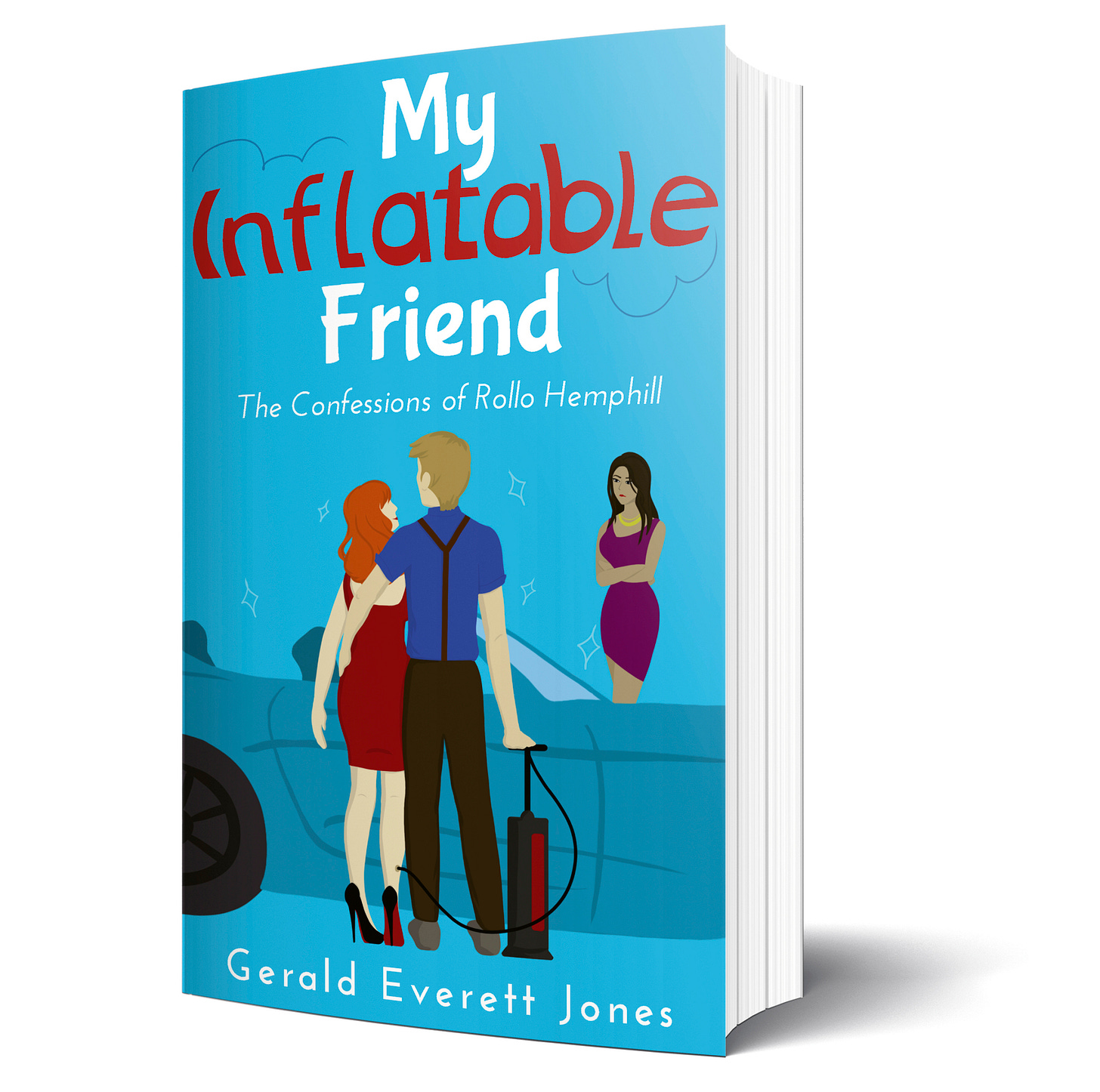When the notion of reissuing Rollo Hemphill’s misadventures floated past in my stream of consciousness, my next thought was, Hey, those stories are evergreen — why not? But more practical considerations of the publishing marketplace prevailed, necessitating this explanatory note.
My concern isn’t that the characters won’t be relatable or their follies any less funny in the glare of freshly fired-up high-wattage attention. No, the problem is one of perceived technological obsolescence. The first novel in the series — My Inflatable Friend — was released in 2007. To some of you in the shivering audience for whom first impressions can be cool if not downright cold, that era might not seem so long ago. But to others, the crusty tale might as well have occurred just before the undocumented end of the last Ice Age. (There have been more than one, I’m told. Hence the rush to print again, lest the next big freeze overtake us. Hmm. Some in fire, some in ice. We probably don’t get to pick.)
The original release of the first book in the Rollo Hemphill Misadventures predated the introduction of the iPhone. How were hookups even possible back then?
When the first novel in the series was released, cell phones existed but weren’t yet what you’d call smart. Email was a thing, surely, but social media had not yet turned the world’s great newspapers into ezines for old folks.
Some Luddites still clung to their fax (facsimile) machines, especially those who insisted that electronic signature was an oxymoron.
Some movie crews who were filming were still actually using film. Likewise for shows taping.
Into this latter-day Age of Innocence schlepped poor Rollo, whose challenges getting attention from females, then avoiding journalists and G-men, could no doubt have been helped by the option of sending the occasional exculpatory text message. Emojis wouldn’t have hurt his cause either, and an amusing animation, especially if cloned onto his bodily image as a wisecracking avatar, might have put him right over the top. (Or on the bottom. At the outset, positional advantage was far from his foremost concern.)
Back then, climate change could have been mitigated — or didn’t exist — depending on which talking head you credited. In fact, end-of-the-world-as-we-know-it was mostly a worn-out sci-fi theme, hardly a topic of almost unremitting daily conversation. A pandemic was a post-WWI episode, not feared to be repeated because threats such as Ebola and AIDS had presumably been contained. The James Bond movie franchise was still going strong because male guilt, belatedly dredged up by #MeToo, had not yet made it necessary (spoiler alert!) to kill the legendary rapist off.
And — perhaps most significant for the sake of Rollo’s first episode — lifelike robots designed for intimate uses may have been in development but were certainly not yet ready for the likes of Rollo.
Mind you, Rollo’s stories need not be read in sequence. Rubber Babes exists in its own quirky paranoid reality, and Farnsworth’s Revenge is no less sweet when not saved for last, but the through-line of Rollo’s lurching character development does flow in a bobbing chronology through these books. Wise readers will know better than to regard him as a role model. Rollo’s problem — if you insist on calling it that — is paradoxical: No matter what scheme he tries or how it fails — he persists in falling ever-upward.
I could wonder, though, whether male-centered comic humor can be written anymore. Men seem more pathetic than funny now, as do some who oddly claim to be both white and marginalized. Satire might still be a useful term, but nowadays its connotations tend to be political. Rollo does get enmeshed in complications on an international scale — but he has no agenda other than self-preservation.
My original inspiration for these novels was my admiration for the novelist and poet Peter De Vries. In the mid-twentieth century, his male-centered comic novels ridiculed religion and extramarital sex — often in the same book. However, the whiff of controversy, so delicious in his day, has not aged well, and some would say positively reeks. In Forever Panting (my favorite), an out-of-work actor divorces his wife and marries his mother-in-law, continuing to lust after his ex. In Slouching Toward Kalamazoo, a female high-school teacher carries on an affair with her tender-aged male student.
Such themes are not exactly fodder for popular humor these days.
Only one of several possible answers to the question, What or who is his inflatable friend?
Lest you think I’m preoccupied with peters, I’ll confess that the works of Peter Lefcourt also influenced me. The Woody is brilliant, and by virtue of its inside-the-Beltway setting, it qualifies as legitimately political satire. (Alas, whether Lefcourt was satirizing Gary Hart or Bill Clinton or both is a question not likely to be explored by any contemporary book club.) And he wrote Eleven Karens when it was still possible to bestow the name on a newborn girl.
As well, when I began to stir the pot of silliness on my own, the publishing business had finally been taken over by women — along with the belated recognition that, for decades if not since Gutenberg, the most avid readers have been women. The genre chick-lit had come full flower. Appreciating the polar opposites such as De Vries and Lefcourt, I coined the term boychik lit as a lodestar for sinking ships helmed by ill-fated peters.
So, by way of further explanation — as if any more of my rants were needed to cheer you on to root for Rollo — I append my essay “Boychik Lit” at the end of this volume.
Thank you for the use of the genre. If Rollo’s exploits bring a smile, you needn’t tell anyone.
The first book in this series of silly comedies is permafree—permanently free as Kindle or EPUB ebook. (Or, at least, indefinitely, temporarily zero bucks.)
Looking back now, it appears I was ahead of my time:





